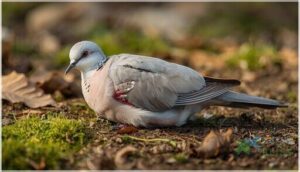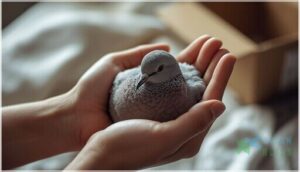This site is supported by our readers. We may earn a commission, at no cost to you, if you purchase through links.
You step outside with your morning coffee and spot a dove on the lawn, perfectly still. Minutes pass—no movement, no flight response when you approach. Something’s wrong.
Doves naturally forage on the ground and pause to rest, but a healthy bird won’t ignore nearby activity or sit frozen in one spot for extended periods. The difference between normal behavior and genuine distress isn’t always obvious, yet recognizing those subtle signals determines whether a dove survives the next few hours.
Understanding what to look for—and what steps to take immediately—gives you the knowledge to respond effectively when time matters most.
Table Of Contents
- Key Takeaways
- Why is My Dove Sitting on The Ground?
- Recognizing Signs of Injury or Illness in Doves
- Immediate Steps to Help an Injured Dove
- When and How to Seek Professional Help
- Preventing Dove Injuries and Supporting Recovery
- Frequently Asked Questions (FAQs)
- Why are doves sitting on the ground?
- What to do if you find a dove on the ground?
- What does it mean when a dove stays around?
- How long do doves stay on the ground?
- How long can a dove survive with internal injuries untreated?
- Can doves recover from head trauma or concussions if untreated?
- How can I prevent doves from colliding with windows safely?
- Can doves survive window collisions without intervention?
- How long does dove rehabilitation typically take?
- What diseases spread between doves and backyard birds?
- Conclusion
Key Takeaways
- A healthy dove won’t sit frozen in one spot ignoring nearby activity—if it allows close approach without fleeing, shows fluffed feathers, labored breathing, or closed eyes for extended periods, it needs immediate wildlife rehabilitation.
- Physical trauma signs like uneven wing height, visible wounds, or inability to grip demand swift professional care, while behavioral red flags—panting at rest, non-responsiveness, or complete stillness lasting hours—point to respiratory distress or neurological damage that won’t resolve without intervention.
- Your first actions matter most: approach slowly, use a towel for gentle capture, place the dove in a dark ventilated box with partial heat (around 85°F), and resist offering food or water since birds in shock can aspirate fluids—then contact a licensed wildlife rehabilitator within 48 hours when survival rates jump from under 16% to over 70%.
- Prevent future injuries by applying window decals spaced 2–4 inches apart, keeping cats indoors, planting native cover that provides 70% or more vegetation, and positioning feeders in open sight lines where doves can spot predators while they forage.
Why is My Dove Sitting on The Ground?
Spotting a dove sitting motionless on the ground can leave you wondering if something’s wrong or if it’s just taking a break. Doves naturally spend time on the ground for feeding, sunbathing, or resting, but certain behaviors signal a problem that needs your attention.
Let’s look at how to tell the difference between normal dove behavior and signs that the bird needs help.
Natural Dove Behaviors Vs. Signs of Distress
Doves naturally spend hours ground resting, foraging for seeds scattered across your yard or field. That’s why spotting one sitting quietly doesn’t automatically signal trouble. Healthy dove behavior includes scanning the area frequently, holding wings symmetrically, and moving within minutes.
But dove body language shifts dramatically when something’s wrong. Watch for feather conditions like sustained puffing—when plumage stays fluffed instead of smoothing after a quick preen. Injured doves often sit motionless for hours, showing stress signals: labored breathing, closed eyes, or zero reaction when you approach. If your dove sitting on ground allows close contact without fleeing, wildlife rehabilitation may be needed. Recognizing common health issues is vital to provide proper care.
Common Causes for Immobility in Doves
Understanding what immobilizes your grounded bird helps you decide whether dove rescue and rehabilitation is urgent. Collision impacts with windows account for hundreds of millions of avian deaths annually in the U.S., leaving survivors with head trauma injuries, concussions, and fractures that make flight impossible. Environmental toxins like pesticides trigger neurological disorders—ataxia, tremors, weakness—rendering doves unable to respond when you approach.
Infectious diseases add another layer: trichomoniasis causes oral lesions that prevent feeding, while paramyxovirus produces torticollis and leg weakness. Ground hazards like predator strikes create wing fractures seen in nearly one-fifth of wildlife rehabilitator admissions. Injured dove behavior—fluffed feathers, closed eyes, labored breathing—demands immediate contact with an avian vet. The presence of paramyxovirus disease can lead to severe neurological symptoms and high mortality rates in affected bird populations.
Identifying Normal Resting Vs. Illness
Once you’ve ruled out the obvious causes—window strikes, toxins, disease—it’s time to separate normal rest patterns from real trouble. Wildlife rehabilitation professionals rely on three quick health checks:
- Posture and feather condition: A healthy dove sits upright with sleek plumage; fluffed feathers signal illness.
- Breathing quality: Watch for labored breaths or tail-bobbing—hallmarks of avian health problems.
- Response to approach: Normal ground posture includes alertness; an injured dove won’t flinch when you get close.
Those clues tell you everything.
Recognizing Signs of Injury or Illness in Doves
Once you’ve spotted a dove sitting still on the ground, the next step is figuring out whether it’s just taking a breather or actually in trouble. Healthy doves have smooth feathers and alert eyes, while injured or sick birds show specific warning signs that are hard to miss.
Let’s walk through what to look for so you can tell the difference and respond quickly if something’s wrong.
Visible Wounds, Fractures, and Wing Injuries
Physical trauma speaks loudest when you first spot a grounded dove—look for wings held at uneven heights, blood staining feathers, or limbs twisted at wrong angles. Wing fracture repair in avian orthopedics often treats injuries where one wing drags behind or hangs noticeably lower. Window strikes can expose bone through torn skin, while trembling or inability to grip signals damaged nerves requiring immediate trauma response from a wildlife rehabilitator or avian vet.
These visible injuries demand swift action—flight rehabilitation and proper bone healing depend on getting your injured dove professional care fast.
Lethargy, Fluffed Feathers, and Swollen Eyelids
Exhaustion sometimes wears a disguise—when you notice a dove puffed up like a cotton ball, barely blinking, with puffy or swollen eyelids, you’re witnessing systemic diseases or eye infections that demand swift action. These aren’t rest behaviors; they’re red flags pointing to respiratory issues, salmonella, or trichomoniasis that can kill within days. Wildlife rehabilitation centers confirm that combining these symptoms drops survival sharply without an avian vet’s intervention:
- Fluffed feathers signal the dove is desperately conserving warmth during illness
- Swollen eyelids often reveal conjunctivitis or paramyxovirus
- Lethargy makes the injured dove approachable—never normal dove behavior
- Combined signs require immediate professional care for any chance of recovery
Behavioral Clues: Weakness, Panting, and Non-Responsiveness
Movement freezes, eyes droop half-shut, and breath comes in sharp little gasps—when you spot these behaviors in a dove sitting on the ground, you’re looking at respiratory distress or systemic weakness that won’t resolve on its own. Dove panting, especially with an open beak and labored chest movement, signals compromised oxygen exchange often linked to infection or heat stress.
Grounded behavior paired with non-responsiveness—where your injured dove ignores your approach entirely—indicates neurological problems or profound exhaustion that demands wildlife rehabilitation expertise within the hour. These weakness signs don’t mimic normal rest; healthy doves stay alert and flee when threatened.
Understanding avian health and behavior means recognizing that panting at rest, inability to fly, and altered consciousness form a cluster pointing to critical illness, not simple fatigue—and dove conservation starts with knowing when immediate professional intervention gives your bird its only fighting chance.
Signs of Shock and Stress in Doves
Recognizing a shock response in your injured dove isn’t always straightforward—fluffed plumage, labored breathing, and complete stillness often signal circulatory collapse rather than simple fear. Stress markers like half-closed eyes and cool extremities reveal physiological distress, while tonic immobility—that eerie freeze response—indicates extreme threat perception tied to elevated corticosterone levels. Plumage indicators and behavioral cues together inform wildlife rehabilitation decisions critical to dove conservation.
Watch for these avian health and behavior red flags in dove behavior and health:
- Ruffled feathers paired with weak or absent escape attempts
- Glassy, unfocused eyes and irregular breathing rhythm
- Motionless posture lasting minutes despite your approach
- Visible shivering or unusually cool feet and legs
- Complete indifference to nearby movement or sound
Immediate Steps to Help an Injured Dove
If you’ve determined the dove needs help, your next move matters. Acting quickly but calmly can make the difference between recovery and further harm.
Here’s how to handle the situation safely for both you and the bird.
Safely Approaching and Handling Doves
A panicked approach can send even a weak dove into shock. Move slowly—wildlife rehabilitators call it “becoming invisible”—and watch the dove’s behavior as you close the distance. If it doesn’t flee, gently drape a lightweight towel over its body for gentle capture and dove restraint. Low-stress handling means securing both wings close to its sides in one smooth motion. Quickly scan for wounds, note its breathing pattern, then tuck the injured dove into a ventilated box lined with soft cloth. Safe transport starts with injury assessment—and minimal drama.
| Action Step | Why It Matters | What to Do |
|---|---|---|
| Slow approach | Reduces panic and cardiovascular stress in an injured dove | Keep movements deliberate; pause if the bird shows agitation |
| Towel capture | Contains wings safely during dove restraint | Cover bird’s head and body; lift with wings secured to sides |
| Quick health scan | Guides next steps in wildlife rescue response | Check for visible bleeding, wing asymmetry, labored breathing |
| Immediate containment | Limits further trauma during safe transport to wildlife rehabilitator | Place in dark, quiet box; avoid handling once secured |
Creating a Calm and Warm Recovery Box
Think of the recovery box as a cocoon—a quiet sanctuary where your injured dove can focus on healing instead of fighting fear or cold. Choose a container sized so the bird can stand and turn but not flap wildly, and add several finger-sized box ventilation holes for fresh air. Line the base with kitchen towels or soft bedding materials—nothing fluffy that tangles claws—then position a low-setting heating pad beneath half the box to offer warmth levels around 85 °F, letting the dove move to cooler zones.
Place this recovery container in a calm environment away from pets, children, and noise, creating the darkness that wildlife rehabilitation experts know lowers stress in prey birds, supporting avian health and natural dove behavior during wildlife rescue.
Key Setup Steps:
- Darkness and quiet: Cover most of the box with a towel to block light and household commotion, helping the bird rest without constant visual stimulation.
- Partial heat source: Position the warming pad under one side only, so your dove can self-regulate its body temperature and avoid overheating.
- Non-slip, clean surface: Use paper towels or a thin cloth base—easy to replace, safe for delicate feet, and free of loose threads that could trap toes.
Avoiding Further Injury and Reducing Stress
Once your injured dove is secure in its recovery box, the real work is hands-off: minimizing handling and letting stillness do the heavy lifting. Every peek inside, every voice near the container, every shuffle of the box triggers a stress response that can worsen shock or reopen wounds.
Wildlife rehabilitation experts confirm that reducing noise and maintaining a calm environment are cornerstones of stress management and animal welfare. Position the box somewhere dark and undisturbed—away from pets, foot traffic, and curious kids—then walk away.
This gentle capture approach respects dove behavior and habitat needs, giving your dove sitting on ground the quiet it desperately needs to stabilize.
When to Withhold Food or Water
After your dove is settled and quiet, resist the urge to offer food or water immediately. Birds in shock or with head trauma can’t swallow properly, and oral fluids can slip into the airway—causing aspiration and drowning.
Dehydration risks and crop stasis are real, but fluid therapy and emergency hydration belong with wildlife rehabilitation centers trained in aspiration prevention.
Until a professional assesses your dove sitting on the ground, warmth and stillness outweigh any attempt at dove nutrition and hydration.
When and How to Seek Professional Help
Some situations are beyond home care, and that’s when you need to call in the experts. Knowing who to contact and what to expect can save precious time when a dove’s life hangs in the balance.
Here’s how to find the right help and get your injured dove the professional care it needs.
Contacting Local Wildlife Rehabilitators
When you spot a dove that won’t fly away, reaching a licensed wildlife rehabilitator should be your very first move. These specialists hold the legal permits and training to care for native birds—something that’s required under federal law for doves. Start by searching online rehabilitator directories or calling wildlife hotlines maintained by your state’s fish and game department. Many regions now offer Animal Help Now, a platform that provides emergency contacts based on your ZIP code.
Before you dial, jot down what you’ve observed—closed eyes, wing droop, or visible wounds. That information helps rehabilitators assess urgency. Here’s your quick action list:
- Check your state wildlife agency’s website for local referrals
- Contact animal control or humane societies for rehab center protocols
- Ask your vet for wildlife rehabilitation centers nearby
- Confirm transport instructions and intake hours before you go
Finding Avian Veterinarians for Expert Care
While wildlife rehabilitation centers handle most injured dove cases, sometimes you need a veterinarian with avian medicine training—especially for trauma or acute illness. These specialists are rare: only around 125 board-certified avian clinics exist nationwide, mostly in urban areas.
To locate one fast, use the Association of Avian Veterinarians’ online directory or Lafeber’s ZIP-code tool. Can’t find anyone local? Telehealth platforms now connect you with remote avian specialists for triage advice.
Expect basic exams to run $150–$250, with bird emergency visits climbing much higher depending on diagnostics and treatment.
What to Expect During Veterinary Assessment
Once you hand over your dove, the veterinarian will conduct a thorough veterinary exam, checking breathing, body weight, and feather condition before any handling. They’ll palpate wings and legs for fractures, then discuss diagnostic tests like X-rays or blood work to assess internal trauma.
Expect a conversation about injury assessment findings, rehabilitation plans, and whether your bird is stable enough for avian care procedures. Most exams wrap up in under ten minutes, giving you a clear picture of what comes next in wildlife rehabilitation.
Importance of Timely Professional Intervention
Timing shapes survival when you’re dealing with an injured dove sitting on the ground, not moving. Emergency response within the first 48 hours gives traumatized birds access to avian first aid—fluid therapy, oxygen support, and trauma care that stabilizes shock before it turns fatal. Wildlife rehabilitator data shows professionally treated birds achieve release rates above 70% when care starts early, versus under 16% when delayed.
Emergency care within 48 hours raises injured dove survival from under 16% to over 70%
Quick action matters for:
- Shock management – Immediate fluid therapy prevents organ failure
- Injury assessment – X-rays catch internal bleeding before it’s too late
- Wildlife laws compliance – Reporting within 48 hours protects threatened species
- Conservation impact – Each saved bird strengthens local populations
Dove behavior and health deteriorate fast without expert intervention, so don’t wait to seek wildlife rehabilitation and conservation resources.
Preventing Dove Injuries and Supporting Recovery
Once you’ve helped an injured dove, your next concern is making sure it doesn’t happen again. Simple changes around your home can reduce risks for doves and give them a fighting chance at survival.
Here’s how you can create a safer environment and support these resilient birds in your community.
Making Your Yard Safer for Doves
Think of your backyard as a refuge where every choice you make can save a life. Homes account for roughly 44% of bird-building collision deaths in the United States—that’s about 253 million birds annually. You can shift those odds by applying window decals to prevent strikes, choosing native plantings and native shrubs that support natural food sources, and positioning bird-friendly feeders in open areas where doves can spot danger.
Properties with at least 70% native plant cover support two to three times more birds than non-native landscapes, turning your yard habitat into a cornerstone of dove conservation and broader wildlife conservation efforts through thoughtful bird-friendly landscaping.
| Yard Feature | Bird-Safe Action | Impact on Dove Safety |
|---|---|---|
| Windows | Apply decals or film to glass | Prevents collision injuries and fatal strikes |
| Vegetation | Plant 70%+ native cover and native shrubs | Triples bird abundance and natural food availability |
| Feeders | Place bird-friendly feeders in open sight lines | Reduces predator ambush risk while feeding |
| Chemicals | Eliminate pesticides entirely | Increases species richness and protects food sources |
Reducing Predation and Environmental Hazards
Across your yard, predator control and habitat protection work hand in hand to cut risks doves face daily. Free-ranging cats alone kill up to 4 billion birds each year in the U.S., so keeping yours indoors is critical.
Apply window safety markers to prevent window collisions—over 1 billion birds die this way annually. Trim dense cover where predators ambush, position feeders in open sight lines for predator avoidance, and moderate outdoor lighting.
These environmental factors affecting doves, combined with noise reduction and thoughtful urban planning, transform your space into a refuge supporting wildlife conservation efforts.
Providing Safe Food, Water, and Shelter
Your dove needs three essentials woven together: grain-based food like millet or cracked corn scattered low for ground feeding, water refreshed daily to prevent disease (Water Quality Control), and dense shrubs offering predator-proof cover.
More than 57 million Americans feed wild birds, yet BirdFriendly Feeders placed correctly prevent injury—position yours with clear sight lines and natural shelter nearby.
These Habitat Enhancement Strategies, rooted in Avian Nutrition Guidance and Shelter Design Principles, transform your yard into a haven where Dove Behavior and Habitat align, reducing the need for Wildlife Rehabilitation.
Supporting Local Dove Conservation Efforts
Your backyard can become a lifeline in a larger network when you engage with local dove conservation efforts. Start by joining citizen science platforms like eBird—over 1 billion observations worldwide now shape avian conservation policy. Report dove sightings to track population trends and support wildlife conservation decisions rooted in real data.
Connect with your state’s banding programs; volunteers who share band numbers contribute directly to dove monitoring studies that measure survival and habitat preservation success. Advocate for conservation funding through community meetings—hunters and birdwatchers together invest millions annually in wildlife protection.
Plant native shrubs as part of BirdFriendly Landscaping initiatives, and reach out to your nearest wildlife rehabilitator to learn how dove behavior and habitat observations strengthen regional bird conservation status. Small actions, multiplied across neighborhoods, shift the survival odds for every grounded dove.
Frequently Asked Questions (FAQs)
Why are doves sitting on the ground?
While most birds hop branch to branch, mourning doves defy expectation—they’re built for ground life.
You’ll spot them foraging for seeds, sunbathing with wings outstretched, or dust-bathing in shallow soil depressions.
What to do if you find a dove on the ground?
When you discover an injured dove, assess from a distance for wounds or distress signs. Gently place it in a dark, ventilated box and contact a wildlife rehabilitator immediately for proper bird first aid.
What does it mean when a dove stays around?
When a wild bird lingers near you without flying away, it’s often a distress signal rather than trust. Healthy doves flee quickly when approached—staying put usually indicates injury, illness, or exhaustion requiring immediate wildlife rehabilitation intervention.
How long do doves stay on the ground?
Here’s the thing: ground time factors vary widely for doves. Healthy birds spend 10–30 minutes foraging or sunbathing, but fledgling development keeps young doves grounded 3–4 days post-nest while building flight strength.
How long can a dove survive with internal injuries untreated?
Unfortunately, a dove with serious untreated trauma usually survives only hours to two days. Internal bleeding and shock claim most victims within 48 hours, making swift wildlife rehabilitation intervention absolutely critical for survival probability factors.
Can doves recover from head trauma or concussions if untreated?
Head trauma in doves carries a grim prognosis without professional care.
Studies show only about 40% of collision-injured birds recover even with treatment—untreated concussions usually cause fatal neurological decline or predation.
How can I prevent doves from colliding with windows safely?
Ironically, we’ve perfected invisible glass but not invisible danger.
Apply bird-friendly window decals or glass markers spaced 2–4 inches apart across your windows. External netting barriers and screens offer solid collision prevention—making your yard safer while supporting wildlife conservation and healthier bird behavior.
Can doves survive window collisions without intervention?
Window collisions kill most doves without help—only about 40% survive even with expert care.
Internal injuries like brain trauma often prove fatal within days, making immediate wildlife rehabilitator intervention critical for recovery odds.
How long does dove rehabilitation typically take?
Rehab timeframes depend on injury assessment and release criteria. Minor soft-tissue trauma often resolves in two to four weeks, while fractures or feather damage can extend dove recovery to several months under wildlife rehabilitator protocols.
What diseases spread between doves and backyard birds?
Your feeder becomes a crossroads where invisible threats flow like groundwater. Trichomoniasis transmission, salmonellosis risk, and psittacosis infection spread through shared food and water, while paramyxovirus and fungal hazards lurk in contaminated spaces.
Conclusion
Over 80% of grounded doves brought to rehabilitators could have been saved with earlier intervention. When you encounter a dove sitting on the ground not moving, those first moments define its chances.
Trust what you’ve observed—the fluffed feathers, the stillness that feels wrong, the reluctance to fly. You now understand the signals that separate a bird resting from one fighting for survival.
Act decisively, handle gently, and connect with professionals quickly. That knowledge transforms concern into effective rescue.
- https://nycbirdalliance.org/take-action/help-a-bird-in-trouble/what-to-do-if-you-find-an-injured-bird
- https://www.learnbirdcare.com/post/window-strike-injuries-in-wild-birds
- https://www.fws.gov/story/what-do-if-you-find-baby-bird-injured-or-orphaned-wildlife
- https://ontarionature.org/tips-for-helping-an-injured-bird-blog/
- https://pmc.ncbi.nlm.nih.gov/articles/PMC10252006/











